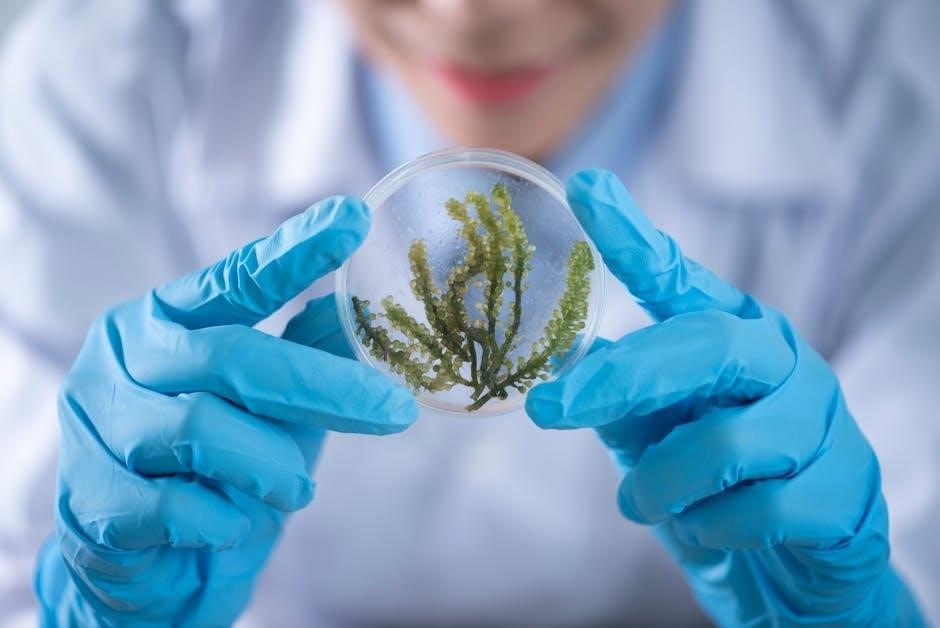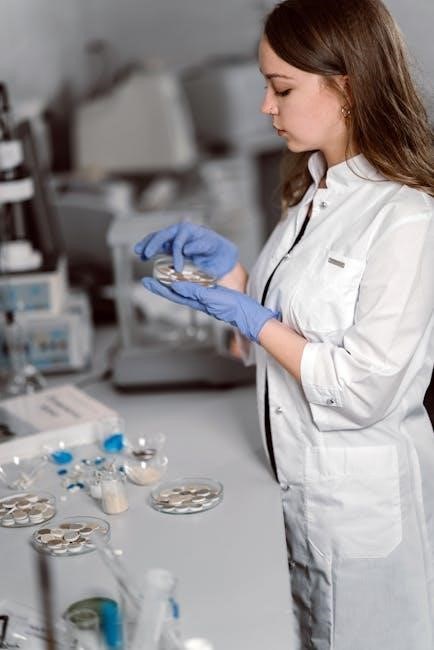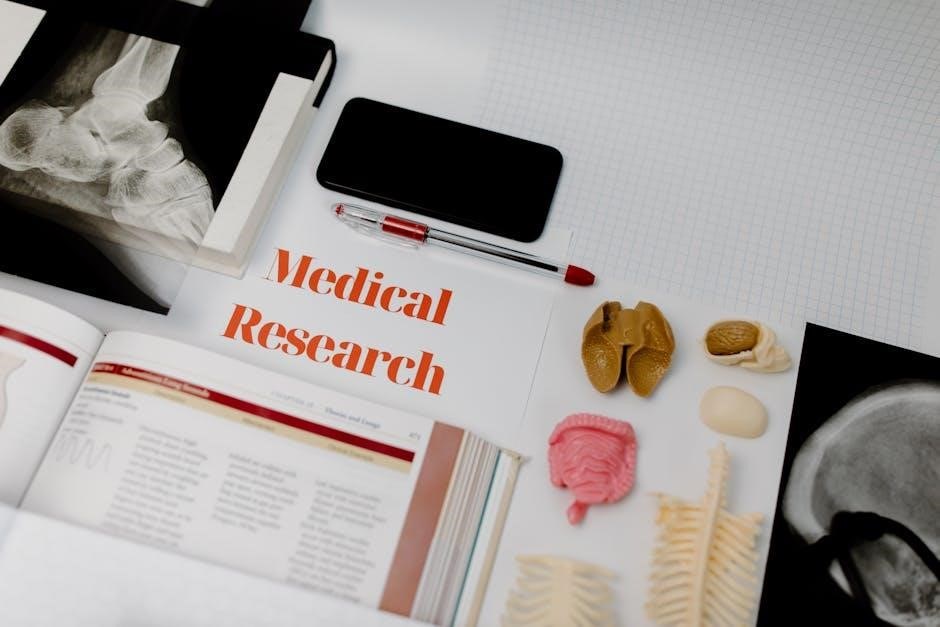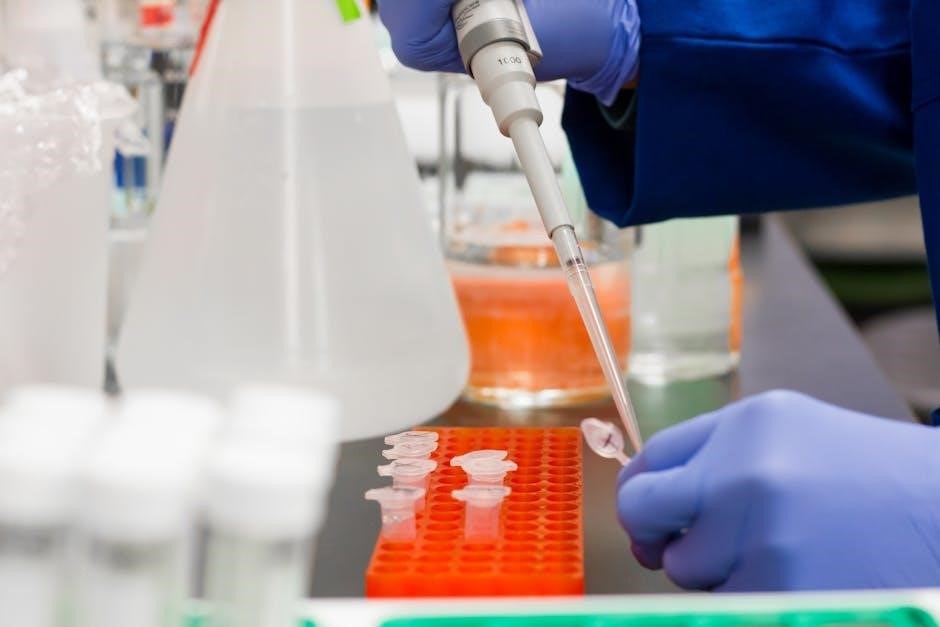This manual provides a comprehensive guide for conducting general chemistry experiments, emphasizing safety, proper techniques, and data interpretation to foster a deep understanding of chemical principles.
1.1. Purpose and Scope of the Manual
The purpose of this manual is to provide students with a clear, structured guide for navigating general chemistry laboratory courses. It outlines essential safety protocols, experimental procedures, and data interpretation techniques. The scope includes practical applications of theoretical concepts, ensuring students develop proficiency in laboratory techniques, critical thinking, and problem-solving. Key areas covered are calibration of instruments, handling of hazardous chemicals, and accurate documentation of results. This manual serves as a foundational resource, preparing students to apply chemical principles effectively in various experimental scenarios while adhering to safety standards and best practices.
- Emphasizes safety and proper laboratory practices.
- Covers calibration, data collection, and analysis.
- Prepares students for diverse experimental challenges.
1.2. Key Objectives of the Laboratory Course
The primary objectives of the laboratory course are to develop practical skills, reinforce theoretical concepts, and foster scientific inquiry. Students will learn to operate laboratory equipment, conduct experiments accurately, and analyze data to draw meaningful conclusions. Emphasis is placed on safety, teamwork, and clear communication of results. Through hands-on experiences, students will cultivate problem-solving abilities and apply chemical principles to real-world scenarios, preparing them for advanced studies and professional environments.
- Mastering laboratory techniques and equipment usage.
- Enhancing analytical and critical thinking skills.
- Promoting collaboration and effective communication.

Safety Protocols and Emergency Procedures
Adhering to safety protocols is crucial in chemistry labs to prevent accidents. Proper use of protective gear, handling hazardous materials, and knowing emergency responses are emphasized.

2.1. Essential Safety Equipment and Their Uses
In a chemistry lab, essential safety equipment ensures protection from potential hazards. Key items include safety goggles, gloves, lab coats, and closed-toe shoes to prevent chemical exposure. Fire extinguishers, safety showers, and eyewash stations are critical for emergency response. Fume hoods are used to handle volatile chemicals, reducing inhalation risks. Spill kits are available to contain and clean up chemical accidents. First aid kits are on hand for minor injuries. Proper use of this equipment is vital to maintaining a safe working environment and preventing accidents. Familiarizing oneself with the location and operation of these devices is a fundamental step in laboratory safety protocols.
2.2. Handling Hazardous Chemicals and Emergency Response

Handling hazardous chemicals requires strict adherence to safety protocols to minimize risks. Always wear appropriate PPE, including gloves and goggles, when working with potentially dangerous substances. In case of a chemical spill, evacuate the area immediately and notify others. Use spill kits to contain and neutralize the spill, following specific procedures for different types of chemicals. For skin or eye exposure, flush the affected area with water and seek medical attention promptly. Fire emergencies should be addressed with fire extinguishers rated for chemical fires. Familiarize yourself with emergency exit routes and assembly points. Regular training and drills ensure preparedness for such situations, emphasizing quick and coordinated responses to maintain safety in the laboratory environment.

Laboratory Equipment and Materials
This section covers essential laboratory equipment and materials, including balances, glassware like beakers and flasks, pipets, burettes, and heating devices, crucial for accurate measurements and safe experimentation.
3.1. Calibration and Use of Measuring Instruments
This section outlines the proper techniques for calibrating and using laboratory measuring instruments, such as pipets, burettes, and balances. Calibration ensures accuracy and reliability in measurements, which are critical for experimental success. Regular maintenance and adherence to manufacturer guidelines are emphasized to prevent errors. Students learn to handle instruments safely and record data precisely, fostering a systematic approach to experimentation. Proper use of measuring tools is essential for achieving consistent and reproducible results, a cornerstone of scientific inquiry in chemistry.
3;2. Common Laboratory Glassware and Apparatus
Common laboratory glassware includes beakers, flasks, test tubes, and graduated cylinders, each designed for specific tasks. Beakers are used for mixing and heating solutions, while flasks are ideal for storing or reacting chemicals. Test tubes are essential for small-scale reactions and observations. Graduated cylinders measure precise liquid volumes. Other apparatus like burettes, pipets, and volumetric flasks are crucial for titrations and accurate measurements. Hot plates, Bunsen burners, and thermometers are used for heating and temperature control. Understanding the proper use and care of this equipment ensures safe and efficient experimentation. Familiarity with these tools is fundamental for mastering laboratory techniques in general chemistry.

Conducting Experiments and Recording Data
Plan experiments meticulously, ensuring all required chemicals and equipment are available. This approach minimizes waste and enhances safety and efficiency in the laboratory setting.
4.1. Preparing for Experiments and Following Protocols
Proper preparation is crucial for the success of any chemistry experiment. Begin by thoroughly reviewing the procedure, understanding each step, and gathering all necessary materials and equipment. Ensure all instruments are calibrated and in good working condition. Familiarize yourself with safety protocols and emergency procedures to handle potential hazards. Organize your workspace to maintain clarity and efficiency during the experiment. Always follow established protocols precisely, as deviations can lead to errors or unsafe conditions. Double-check the setup of equipment and the measurement of reagents before starting. Maintaining a clean and orderly workspace helps prevent accidents and ensures accurate results. Preparation and adherence to protocols are key to achieving reliable outcomes in a laboratory setting.
4.2. Accurate Data Collection and Documentation
Accurate data collection and documentation are essential for reliable experimental outcomes. Use calibrated instruments to ensure precise measurements, and record observations immediately to avoid memory errors. Maintain a clean and organized workspace to prevent mix-ups. Document all measurements, including repetitions, in a laboratory notebook using clear and legible handwriting. Include timestamps, descriptions of procedures, and any unexpected occurrences. Data should be presented in tables or graphs where appropriate for clarity. Regularly review and verify recorded information for consistency and accuracy. Proper documentation allows for reproducibility of experiments and facilitates thorough analysis. Clear and detailed records are critical for drawing valid conclusions and communicating results effectively.

Analytical Techniques and Data Interpretation
This section introduces methods like titration and spectrophotometry for analyzing chemical systems. It emphasizes error analysis, data reporting, and interpreting results to draw meaningful conclusions.
- Titrations measure precise concentrations of solutions.
- Spectrophotometry analyzes light absorption for chemical identification.
- Error analysis ensures result reliability.
- Clear reporting communicates findings effectively.
5.1. Understanding Titration and Spectrophotometry
Titration and spectrophotometry are essential analytical techniques in chemistry. Titration involves measuring the concentration of a solution by reacting it with a standard solution of known concentration. This method is widely used to determine the amount of a specific substance in a sample. Spectrophotometry, on the other hand, measures the interaction between light and matter, often used to identify and quantify substances based on their absorption of light at specific wavelengths. Both techniques require precise calibration and careful data collection to ensure accuracy. Understanding these methods is crucial for analyzing chemical systems and interpreting experimental results effectively.
- Titrations are precise for concentration determination.
- Spectrophotometry aids in chemical identification and quantification.
- Calibration and accuracy are key to reliable results.
5.2. Error Analysis and Reporting Results
Error analysis is a critical step in laboratory work, ensuring the reliability and validity of experimental data. It involves identifying and quantifying potential sources of error, such as instrumentation, measurement techniques, or environmental factors. Systematic errors are consistent and can often be corrected, while random errors vary and are minimized through replicate measurements. Accurate reporting of results includes documenting uncertainties and using appropriate significant figures. Clear and honest communication of findings, supported by graphs or tables, is essential for scientific integrity. Proper error analysis enhances the credibility of conclusions and informs improvements in experimental design. Always review and edit reports to ensure clarity and professionalism.
- Identify and quantify sources of error.
- Systematic vs. random errors require different approaches.
- Report results with precision and transparency.
- Document uncertainties and significant figures.